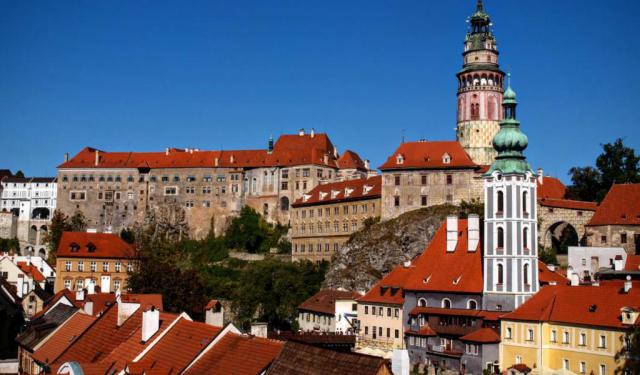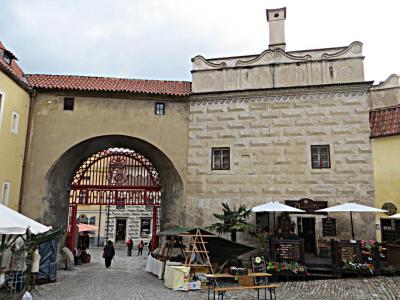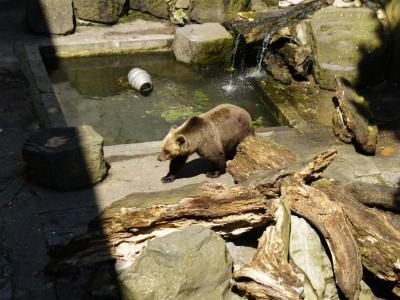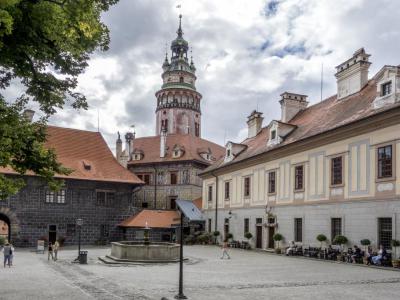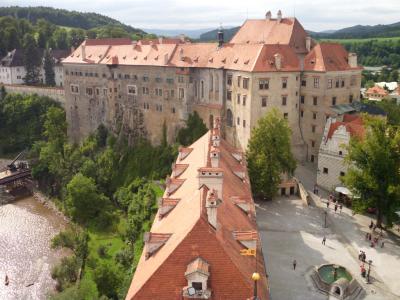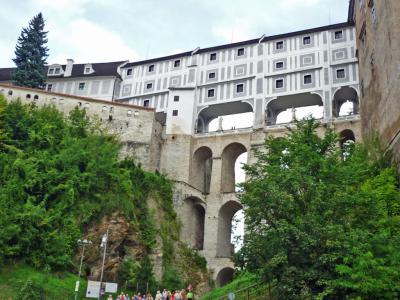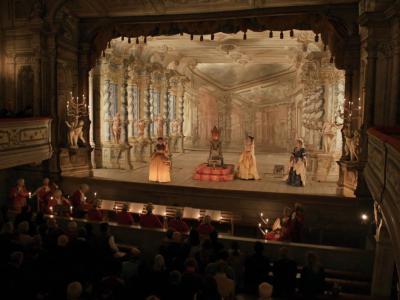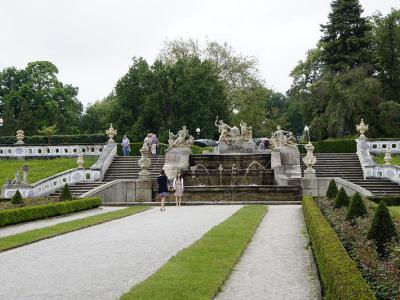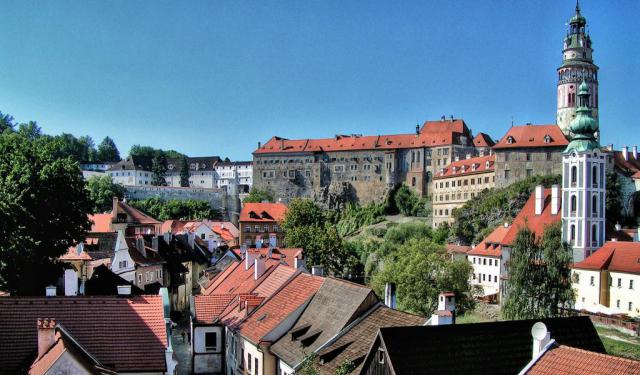Cesky Krumlov Castle Grounds Walk (Self Guided), Cesky Krumlov
Perhaps the main draw of Cesky Krumlov is its imposing castle, looming over the Old Town. Being one of Central Europe's most extensive castle complexes, it boasts a total of 40 buildings and five castle courtyards, making it an undeniably impressive sight. The origins of this castle trace back to approximately 1240, but its current Baroque appearance hails from the late 17th and early 18th centuries. During this period, the castle underwent expansion and saw the addition of several significant architectural elements.
Throughout its long history, this estate was owned by some of the wealthiest and most prominent noble families in the region, including the Rosenbergs, the Eggenbergs, and the Schwarzenbergs. However, following World War II, the property changed hands and was transferred to the Czechoslovak state. Today, it enjoys the status of a UNESCO World Heritage Site, welcoming visitors who have the opportunity to appreciate its magnificent architecture and splendid interiors.
The Red Gate is the grand entrance to the castle complex. The so-called Bear Moat (Medvedi Prikop) is a unique feature of the castle. In the past, bears were kept here instead of water, providing an additional layer of defense.
The Lower Castle is a part of the complex that houses the Castle Museum and Castle Tower. The former showcases artifacts and exhibitions that provide insights into the past, while the latter offers panoramic views of Ceský Krumlov and the surrounding countryside.
The Upper Castle is another section within the complex, featuring the Cloak Bridge (Plastovy Most). This picturesque bridge connects the upper and lower parts of the castle and offers splendid views of the Vltava River.
One of the Castle's highlights is the Castle Baroque Theater, a beautifully preserved historical venue that allows visitors to experience the grandeur of Baroque-era shows.
Finally, the Castle Gardens are a tranquil escape within the castle complex. These terraced gardens offer a peaceful place to relax and enjoy the beauty of meticulously landscaped greenery.
Ceský Krumlov Castle is a stunning historical landmark where you can immerse yourself in the stories of medieval Europe and marvel at the beauty of its surroundings. We hereby encourage you to explore it firsthand with the help of our self-guided walk. It's a journey you won't want to miss.
Throughout its long history, this estate was owned by some of the wealthiest and most prominent noble families in the region, including the Rosenbergs, the Eggenbergs, and the Schwarzenbergs. However, following World War II, the property changed hands and was transferred to the Czechoslovak state. Today, it enjoys the status of a UNESCO World Heritage Site, welcoming visitors who have the opportunity to appreciate its magnificent architecture and splendid interiors.
The Red Gate is the grand entrance to the castle complex. The so-called Bear Moat (Medvedi Prikop) is a unique feature of the castle. In the past, bears were kept here instead of water, providing an additional layer of defense.
The Lower Castle is a part of the complex that houses the Castle Museum and Castle Tower. The former showcases artifacts and exhibitions that provide insights into the past, while the latter offers panoramic views of Ceský Krumlov and the surrounding countryside.
The Upper Castle is another section within the complex, featuring the Cloak Bridge (Plastovy Most). This picturesque bridge connects the upper and lower parts of the castle and offers splendid views of the Vltava River.
One of the Castle's highlights is the Castle Baroque Theater, a beautifully preserved historical venue that allows visitors to experience the grandeur of Baroque-era shows.
Finally, the Castle Gardens are a tranquil escape within the castle complex. These terraced gardens offer a peaceful place to relax and enjoy the beauty of meticulously landscaped greenery.
Ceský Krumlov Castle is a stunning historical landmark where you can immerse yourself in the stories of medieval Europe and marvel at the beauty of its surroundings. We hereby encourage you to explore it firsthand with the help of our self-guided walk. It's a journey you won't want to miss.
How it works: Download the app "GPSmyCity: Walks in 1K+ Cities" from Apple App Store or Google Play Store to your mobile phone or tablet. The app turns your mobile device into a personal tour guide and its built-in GPS navigation functions guide you from one tour stop to next. The app works offline, so no data plan is needed when traveling abroad.
Cesky Krumlov Castle Grounds Walk Map
Guide Name: Cesky Krumlov Castle Grounds Walk
Guide Location: Czech Republic » Cesky Krumlov (See other walking tours in Cesky Krumlov)
Guide Type: Self-guided Walking Tour (Sightseeing)
# of Attractions: 8
Tour Duration: 1 Hour(s)
Travel Distance: 0.9 Km or 0.6 Miles
Author: DanaOffice
Sight(s) Featured in This Guide:
Guide Location: Czech Republic » Cesky Krumlov (See other walking tours in Cesky Krumlov)
Guide Type: Self-guided Walking Tour (Sightseeing)
# of Attractions: 8
Tour Duration: 1 Hour(s)
Travel Distance: 0.9 Km or 0.6 Miles
Author: DanaOffice
Sight(s) Featured in This Guide:
- The Red Gate
- Medvedi Prikop (Bear Moat)
- Lower Castle
- Castle Museum and Castle Tower
- Upper Castle
- Plastovy Most (Cloak Bridge)
- Castle Baroque Theater
- Castle Gardens
1) The Red Gate
The Red Gate serves as the entrance to the 1st courtyard of Český Krumlov Castle, situated between two significant buildings: Castle No. 46 - New Pharmacy and Castle No. 57 - Salt House. Accessible from the Latrán street, this gate consists of a double-winged wooden door adorned with the Schwarzenbergs' coat-of-arms intricately carved into its upper section.
The Red Gate derives its name from the traditional red paint used on its exterior, adding to its distinctive appearance. The gate is set within a brick arch with a corner made of blockstones. The gate's simple saddle roof is covered with hollow tiles, providing a practical and durable roofing solution.
The Red Gate's history can be traced back to the early days of the Lower Castle's advance fortifications, where an initial gate stood. Throughout the 15th century, the area surrounding the gate saw gradual expansion, accommodating new working quarters. Over the centuries, the gate underwent various transformations and modifications, ultimately assuming its present-day form in 1748.
The Red Gate derives its name from the traditional red paint used on its exterior, adding to its distinctive appearance. The gate is set within a brick arch with a corner made of blockstones. The gate's simple saddle roof is covered with hollow tiles, providing a practical and durable roofing solution.
The Red Gate's history can be traced back to the early days of the Lower Castle's advance fortifications, where an initial gate stood. Throughout the 15th century, the area surrounding the gate saw gradual expansion, accommodating new working quarters. Over the centuries, the gate underwent various transformations and modifications, ultimately assuming its present-day form in 1748.
2) Medvedi Prikop (Bear Moat)
Еу Bear Moat is a historic castle moat that spans between the First and Second courtyards of Český Krumlov Castle. In its early days, the moat played a crucial role in protecting the castle's perimeter, including the wall and the tower gate. The tower gate allowed entry to the second courtyard of the castle and was originally equipped with a wooden drawbridge.
One notable transformation occurred in 1760 when the original wooden drawbridge was replaced by a sturdy stone bridge. This stone bridge, adorned with statues of the Virgin Mary and St. Joseph, marked a significant change in the moat's structure and set the stage for its present-day configuration. This bridge is the foundation of the current Bear Moat.
The history of bear breeding at Český Krumlov Castle dates back to the 16th century, during the reign of the Rožmberk family. Bears have been a part of Bear Moat since 1707. Currently, the moat is home to a bear couple named Vok and Kateřina, who welcomed two cubs into the world in 1994. The birth of the cubs was celebrated with enthusiasm, and the bears became a beloved attraction for visitors, especially children.
One of the most cherished events at Český Krumlov Castle is the annual bear celebrations, held every year on Christmas Day. During this festive occasion, children participate by bringing various gifts for the bears. These gifts are placed under a decorated tree, creating a heartwarming and community-driven celebration that continues to delight both locals and visitors.
One notable transformation occurred in 1760 when the original wooden drawbridge was replaced by a sturdy stone bridge. This stone bridge, adorned with statues of the Virgin Mary and St. Joseph, marked a significant change in the moat's structure and set the stage for its present-day configuration. This bridge is the foundation of the current Bear Moat.
The history of bear breeding at Český Krumlov Castle dates back to the 16th century, during the reign of the Rožmberk family. Bears have been a part of Bear Moat since 1707. Currently, the moat is home to a bear couple named Vok and Kateřina, who welcomed two cubs into the world in 1994. The birth of the cubs was celebrated with enthusiasm, and the bears became a beloved attraction for visitors, especially children.
One of the most cherished events at Český Krumlov Castle is the annual bear celebrations, held every year on Christmas Day. During this festive occasion, children participate by bringing various gifts for the bears. These gifts are placed under a decorated tree, creating a heartwarming and community-driven celebration that continues to delight both locals and visitors.
3) Lower Castle
The Lower Castle, often referred to as Little Castle, is situated within the Castle complex. It is accessible via a bridge over the Bear Moat, and a passage leads visitors to this historical gem.
The oldest part of the Lower Castle dates back to the 13th century when it served as an old palace with a tower.
This tower was later enhanced with a Renaissance superstructure and adorned with paintings in 1580. The tower balcony offers a breathtaking panoramic view of both the castle complex and the city of Český Krumlov.
The castle of Krumlov was mentioned in the 13th-century poem of Austrian knight and minstrel Ulrich of Lichtenstein, reflecting its early historical roots. Initially, the Little Castle was part of the fortifications and used as storage space. It was Wilhelm von Rosenberg who transformed the Little Castle into a Renaissance-style residence while still utilizing the building as a storehouse. Over the centuries, it served various purposes, including as a residence, offices, and more.
The Lower Castle features an irregular large courtyard with distinct wings: Eastern and northern wings house the burgrave, which dates back to 1578. The southern wing is known as the "mint." The western corner boasts the Gothic tower of Buttermilk. The facades of these wings are adorned with Renaissance paintings and sgraffitos, adding to the architectural beauty of the castle.
In the center of the courtyard, there is a stone fountain dating back to 1641, enhancing the courtyard's charm and ambiance.
The oldest part of the Lower Castle dates back to the 13th century when it served as an old palace with a tower.
This tower was later enhanced with a Renaissance superstructure and adorned with paintings in 1580. The tower balcony offers a breathtaking panoramic view of both the castle complex and the city of Český Krumlov.
The castle of Krumlov was mentioned in the 13th-century poem of Austrian knight and minstrel Ulrich of Lichtenstein, reflecting its early historical roots. Initially, the Little Castle was part of the fortifications and used as storage space. It was Wilhelm von Rosenberg who transformed the Little Castle into a Renaissance-style residence while still utilizing the building as a storehouse. Over the centuries, it served various purposes, including as a residence, offices, and more.
The Lower Castle features an irregular large courtyard with distinct wings: Eastern and northern wings house the burgrave, which dates back to 1578. The southern wing is known as the "mint." The western corner boasts the Gothic tower of Buttermilk. The facades of these wings are adorned with Renaissance paintings and sgraffitos, adding to the architectural beauty of the castle.
In the center of the courtyard, there is a stone fountain dating back to 1641, enhancing the courtyard's charm and ambiance.
4) Castle Museum and Castle Tower
The Castle Museum, inaugurated in 2011 by the National Heritage Institute, allows visitors to delve into the rich history of the castle and its prominent families. The museum's exhibitions shed light on the significant events associated with the Rožmberk, Eggenberk, and Schwarzenberg dynasties, unveiling the stories behind the castle's evolution over the centuries.
The Castle Tower, an iconic six-story structure, stands proudly on a narrow rocky promontory that overlooks the picturesque town of Latrán and the meandering Vltava River. The tower's architectural origins are a captivating blend of Gothic and Renaissance styles. The ground floor and first floor harken back to the 13th century, while elements such as the second floor, dating to the 14th century, and the Renaissance belfry on the third floor reveal its evolving design. Notably, the tower bears witness to its Gothic roots through a bell from 1406.
Under the skilled guidance of architect Baldassare Maggi of Arogno, the tower underwent a Renaissance transformation in 1581, receiving an elegant arcaded gallery at its peak. Further enhancing its grandeur, Bartoloměj Beránek - Jelínek adorned the tower with mural paintings and intricate figural and architectural motifs in 1590.
Today, the Castle Tower is open to the public, allowing visitors to ascend its heights and savor breathtaking panoramic vistas of Český Krumlov and its enchanting surroundings.
The Castle Tower, an iconic six-story structure, stands proudly on a narrow rocky promontory that overlooks the picturesque town of Latrán and the meandering Vltava River. The tower's architectural origins are a captivating blend of Gothic and Renaissance styles. The ground floor and first floor harken back to the 13th century, while elements such as the second floor, dating to the 14th century, and the Renaissance belfry on the third floor reveal its evolving design. Notably, the tower bears witness to its Gothic roots through a bell from 1406.
Under the skilled guidance of architect Baldassare Maggi of Arogno, the tower underwent a Renaissance transformation in 1581, receiving an elegant arcaded gallery at its peak. Further enhancing its grandeur, Bartoloměj Beránek - Jelínek adorned the tower with mural paintings and intricate figural and architectural motifs in 1590.
Today, the Castle Tower is open to the public, allowing visitors to ascend its heights and savor breathtaking panoramic vistas of Český Krumlov and its enchanting surroundings.
5) Upper Castle
To reach the Upper Castle, visitors must cross a bridge over another moat, which leads from the lower courtyard.
The Upper Castle encompasses the palace of the powerful Rosenberg family and consists of two small courtyards.
The east wing of the Upper Castle houses the renowned Rosenberg rooms on the first floor. These rooms are adorned with exquisite wooden Renaissance ceilings and remnants of paintings. One of the highlights of the Rosenberg rooms is the remarkable collection of Flemish tapestries from Brussels dating back to the 16th and 17th centuries.
In the southern wing of the Upper Castle, visitors will find the castle chapel of Saint Jiří. This chapel, originally Gothic and built at the beginning of the 14th century, was later reconstructed in the Baroque style. On the south side of the Upper Castle, there is the charming Little Rosenberg Chapel, constructed between 1430 and 1440. It features a beautiful Gothic mesh vault.
The west wing of the Upper Castle boasts the spacious Masquerade Hall, which is a true masterpiece of the Rococo period. The hall's wooden box and illusory paintings, created by J. Lederer in 1748, make it a captivating space. The paintings in the Masquerade Hall depict aristocrats enjoying themselves during a masquerade festival. Various representations of Italian and French "Commedia del Arte" figures intermingle with people dressed in Spanish, Turkish, and other national folk costumes.
The illusionary artwork extends to the painted figures of the actors, the aristocratic party, and even parts of the costumes and musical instruments on the balcony of the musicians. The hall is particularly remarkable for its intricate detail and rich depictions of characters and scenes. It's worth noting that the castle's extensive collection contains costumes and musical instruments that likely served as models for the artist.
Adjacent to the Masquerade Hall is the Mirror Hall, which was historically used for carnivals and festive occasions. It was not primarily intended for concerts or theater performances.
The Upper Castle encompasses the palace of the powerful Rosenberg family and consists of two small courtyards.
The east wing of the Upper Castle houses the renowned Rosenberg rooms on the first floor. These rooms are adorned with exquisite wooden Renaissance ceilings and remnants of paintings. One of the highlights of the Rosenberg rooms is the remarkable collection of Flemish tapestries from Brussels dating back to the 16th and 17th centuries.
In the southern wing of the Upper Castle, visitors will find the castle chapel of Saint Jiří. This chapel, originally Gothic and built at the beginning of the 14th century, was later reconstructed in the Baroque style. On the south side of the Upper Castle, there is the charming Little Rosenberg Chapel, constructed between 1430 and 1440. It features a beautiful Gothic mesh vault.
The west wing of the Upper Castle boasts the spacious Masquerade Hall, which is a true masterpiece of the Rococo period. The hall's wooden box and illusory paintings, created by J. Lederer in 1748, make it a captivating space. The paintings in the Masquerade Hall depict aristocrats enjoying themselves during a masquerade festival. Various representations of Italian and French "Commedia del Arte" figures intermingle with people dressed in Spanish, Turkish, and other national folk costumes.
The illusionary artwork extends to the painted figures of the actors, the aristocratic party, and even parts of the costumes and musical instruments on the balcony of the musicians. The hall is particularly remarkable for its intricate detail and rich depictions of characters and scenes. It's worth noting that the castle's extensive collection contains costumes and musical instruments that likely served as models for the artist.
Adjacent to the Masquerade Hall is the Mirror Hall, which was historically used for carnivals and festive occasions. It was not primarily intended for concerts or theater performances.
6) Plastovy Most (Cloak Bridge)
The Cloak Bridge is a historic bridge that serves as a vital link, connecting various parts of the castle, including the Upper Castle, the baroque castle theater, the V. courtyard, and the castle garden.
The bridge itself is a fascinating architectural gem characterized by its multi-story design. Cloak Bridge consists of three levels of arches supported by sturdy pillars. It features an open, covered floor adorned with intricate sculptural decorations, as well as three enclosed floors connected by two corridors. The lower corridor connects the Masquerade Hall with the castle theater, while the upper corridor links the castle picture gallery with the castle garden, continuing on to the Minorite monastery on the Lateran.
One of the distinctive features of the Cloak Bridge is its brick railing, which displays a copy of baroque statues representing significant saints, including St. Anthony of Padua, St. Felix Kantalíčský, St. Wenceslas, and St. John of Nepomuck. The original sculptures of these saints are now showcased in the castle lapidary.
Historically, the location of the bridge was once a moat spanned by a footbridge with a drawbridge during the Middle Ages. Over time, the Cloak Bridge underwent several phases of construction and renovation. It was successively built in 1686, 1707, 1748, and 1765. These transformations contributed to its current baroque appearance.
The bridge itself is a fascinating architectural gem characterized by its multi-story design. Cloak Bridge consists of three levels of arches supported by sturdy pillars. It features an open, covered floor adorned with intricate sculptural decorations, as well as three enclosed floors connected by two corridors. The lower corridor connects the Masquerade Hall with the castle theater, while the upper corridor links the castle picture gallery with the castle garden, continuing on to the Minorite monastery on the Lateran.
One of the distinctive features of the Cloak Bridge is its brick railing, which displays a copy of baroque statues representing significant saints, including St. Anthony of Padua, St. Felix Kantalíčský, St. Wenceslas, and St. John of Nepomuck. The original sculptures of these saints are now showcased in the castle lapidary.
Historically, the location of the bridge was once a moat spanned by a footbridge with a drawbridge during the Middle Ages. Over time, the Cloak Bridge underwent several phases of construction and renovation. It was successively built in 1686, 1707, 1748, and 1765. These transformations contributed to its current baroque appearance.
7) Castle Baroque Theater
The Castle Baroque Theater, located on the Vth courtyard of the castle, behind the moat near the castle's west wing, it is intricately connected to the castle's architecture and heritage. The Castle Theater is known for its exceptional state of preservation and represents a mature form of Baroque stage design.
The theater's origins trace back to the late 15th century when theater culture began to emerge within the Český Krumlov Castle. In 1675, Prince Johann Christian I von Eggenberg initiated the construction of a theater stage in the Deer Hall within the Krumlov Castle. Later, between 1680 and 1682, a new and independent theater building was erected on the 5th courtyard, on the site where the present theater building stands.
The Theater stands out as a magnificent representation of Baroque theater architecture. It possesses an extensive collection of original theater-related items and archival documentation that offers insights into the theater's rich history. This collection includes the theater building itself, the auditorium, orchestra pit, stage, stage technology, machinery, decorations, costumes, props, lighting equipment, fire extinguishers, and more. Additionally, a wealth of archival materials such as librettos, scripts, texts, sheet music, inventories, accounts, iconographic materials, and other historical records provide a comprehensive view of theater life from the 17th to the 19th century.
What makes the Castle Baroque Theater particularly special is its unique state of preservation, with original stage technology and decorations that reflect the illusive European Baroque style. It is noteworthy that only one other royal theater in the world can be compared to the Krumlov Baroque Theater, namely Sweden's Drottningholm Theater near Stockholm, built in 1766. While the Drottningholm Theater also boasts original stage technology, its decorations date from the 1780s and exhibit features of classicism. In contrast, the Krumlov decorations are rooted in the style of European Baroque.
The theater's origins trace back to the late 15th century when theater culture began to emerge within the Český Krumlov Castle. In 1675, Prince Johann Christian I von Eggenberg initiated the construction of a theater stage in the Deer Hall within the Krumlov Castle. Later, between 1680 and 1682, a new and independent theater building was erected on the 5th courtyard, on the site where the present theater building stands.
The Theater stands out as a magnificent representation of Baroque theater architecture. It possesses an extensive collection of original theater-related items and archival documentation that offers insights into the theater's rich history. This collection includes the theater building itself, the auditorium, orchestra pit, stage, stage technology, machinery, decorations, costumes, props, lighting equipment, fire extinguishers, and more. Additionally, a wealth of archival materials such as librettos, scripts, texts, sheet music, inventories, accounts, iconographic materials, and other historical records provide a comprehensive view of theater life from the 17th to the 19th century.
What makes the Castle Baroque Theater particularly special is its unique state of preservation, with original stage technology and decorations that reflect the illusive European Baroque style. It is noteworthy that only one other royal theater in the world can be compared to the Krumlov Baroque Theater, namely Sweden's Drottningholm Theater near Stockholm, built in 1766. While the Drottningholm Theater also boasts original stage technology, its decorations date from the 1780s and exhibit features of classicism. In contrast, the Krumlov decorations are rooted in the style of European Baroque.
8) Castle Gardens (must see)
The Castle Gardens are situated just below Český Krumlov Castle. They are easily accessible and are often included in tourists' itineraries when visiting the charming town.
The Castle Gardens have a rich history dating back to the Renaissance period. They were originally designed in the 17th century, and their layout and landscaping have been meticulously maintained over the centuries. The gardens are an integral part of the Český Krumlov Castle complex, a UNESCO World Heritage Site.
The Gardens are divided into several sections, each with its unique features. Visitors can explore manicured lawns, intricate flowerbeds, tree-lined avenues, and charming pathways that meander through the greenery. The gardens offer stunning views of the Vltava River and the surrounding countryside.
The gardens are an ideal place for relaxation. Visitors can bring a picnic or find a quiet spot to unwind amidst the greenery. The peaceful ambiance and scenic surroundings make it a popular spot for both tourists and locals. The Castle Gardens occasionally host cultural events and performances, making them a venue for art exhibitions, music concerts, and outdoor theater during the summer months.
The Castle Gardens have a rich history dating back to the Renaissance period. They were originally designed in the 17th century, and their layout and landscaping have been meticulously maintained over the centuries. The gardens are an integral part of the Český Krumlov Castle complex, a UNESCO World Heritage Site.
The Gardens are divided into several sections, each with its unique features. Visitors can explore manicured lawns, intricate flowerbeds, tree-lined avenues, and charming pathways that meander through the greenery. The gardens offer stunning views of the Vltava River and the surrounding countryside.
The gardens are an ideal place for relaxation. Visitors can bring a picnic or find a quiet spot to unwind amidst the greenery. The peaceful ambiance and scenic surroundings make it a popular spot for both tourists and locals. The Castle Gardens occasionally host cultural events and performances, making them a venue for art exhibitions, music concerts, and outdoor theater during the summer months.
Walking Tours in Cesky Krumlov, Czech Republic
Create Your Own Walk in Cesky Krumlov
Creating your own self-guided walk in Cesky Krumlov is easy and fun. Choose the city attractions that you want to see and a walk route map will be created just for you. You can even set your hotel as the start point of the walk.
Cesky Krumlov Introduction Walking Tour
Cesky Krumlov is the second most popular tourist destination in the Czech Republic, trailing only Prague, the capital, in terms of visitors. And it’s no wonder since this medieval, UNESCO-listed town is simply the prettiest.
The name Cesky Krumlov has an intriguing etymology, in which "Cesky" means "Czech," while "Krumlov" is derived from the German name... view more
Tour Duration: 2 Hour(s)
Travel Distance: 1.6 Km or 1 Miles
The name Cesky Krumlov has an intriguing etymology, in which "Cesky" means "Czech," while "Krumlov" is derived from the German name... view more
Tour Duration: 2 Hour(s)
Travel Distance: 1.6 Km or 1 Miles
The Most Popular Cities
/ view all
